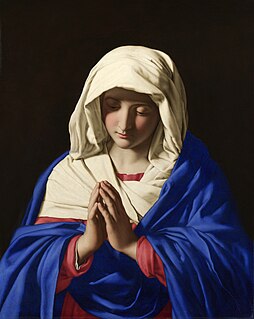Related Research Articles

The Lord's Prayer, also called the Our Father, is a central Christian prayer which, according to the New Testament, Jesus taught as the way to pray:

Prayer is an invocation or act that seeks to activate a rapport with an object of worship through deliberate communication. In the narrow sense, the term refers to an act of supplication or intercession directed towards a deity, or a deified ancestor. More generally, prayer can also have the purpose of thanksgiving or praise, and in comparative religion is closely associated with more abstract forms of meditation and with charms or spells.

The Holy Rosary, also known as the Dominican Rosary, or simply the Rosary, refers to a set of prayers used in the Catholic Church and to the string of knots or beads used to count the component prayers. When referring to the prayer, the word is usually capitalized ; when referring to the beads, it is written with a lower-case initial letter.

In the practice of Christianity, canonical hours mark the divisions of the day in terms of fixed times of prayer at regular intervals. A book of hours, chiefly a breviary, normally contains a version of, or selection from, such prayers.

The Amidah, also called the Shemoneh Esreh, is the central prayer of the Jewish liturgy. This prayer, among others, is found in the siddur, the traditional Jewish prayer book. Due to its importance, it is simply called hatefila in rabbinic literature.
A guardian angel is a type of angel that is assigned to protect and guide a particular person, group or nation. Belief in tutelary beings can be traced throughout all antiquity. The idea of angels that guard over people played a major role in Ancient Judaism. In Christianity, the hierarchy of angels was extensively developed in the 5th century by Pseudo-Dionysius the Areopagite. The theology of angels and tutelary spirits has undergone many changes since the 5th century. Belief in both the East and the West is that guardian angels serve to protect whichever person God assigns them to, and present prayer to God on that person's behalf.

The following are Roman Catholic prayers to Saint Joseph.

Intercession of the saints is a doctrine held by the Eastern Orthodox, Oriental Orthodox, and Roman Catholic Churches. The practice of praying through saints can be found in Christian writings from the 3rd century onward. The 4th-century Apostles' Creed states belief in the communion of saints, which certain Christian churches interpret as supporting the intercession of saints. As in Christianity, this practice is controversial in Judaism and Islam.
The Litany of the Saints is a formal prayer of the Roman Catholic Church as well as the Old Catholic Church, Anglo-Catholic communities, and Western Rite Orthodox communities. It is a prayer to the Triune God, which also includes invocations for the intercession of the Blessed Virgin Mary, the Angels and all the martyrs and saints upon whom Christianity was founded, and those recognised as saints through the subsequent history of the church. Following the invocation of the saints, the Litany concludes with a series of supplications to God to hear the prayers of the worshippers. It is most prominently sung during the Easter Vigil, All Saints' Day, and in the liturgy for conferring Holy Orders, the Consecration of a Virgin and reception of the perpetual vows of a religious or a diocesane hermit.

Lestovka is a special type of prayer rope made of leather, once in general use in old Russia, and is still used by Russian Old Believers today, such as the Russian Orthodox Christians and Russian Orthodox Oldritualist Church, Pomorian Old-Orthodox Church and edinoverians.

The Sinner's Prayer is an evangelical Christian term referring to any prayer of repentance, prayed by individuals who feel convicted of the presence of sin in their lives and have the desire to form or renew a personal relationship with God through Jesus Christ. It is a popular phenomenon in evangelical circles. It is not intended as liturgical like a creed or a confiteor, but rather, is intended to be an act of initial conversion to Christianity. While some Christians see reciting the sinner's prayer as the moment defining one's salvation, others see it as a beginning step of one's lifelong faith journey.
Preces are, in liturgical worship, short petitions that are said or sung as versicle and response by the officiant and congregation respectively. This form of prayer is one of the oldest in Christianity, finding its source in the pre-Christian Hebrew prayers of the Psalms in Temple Worship.

Prostration is the placement of the body in a reverentially or submissively prone position as a gesture. Typically prostration is distinguished from the lesser acts of bowing or kneeling by involving a part of the body above the knee touching the ground, especially the hands.
Eastern Orthodox worship in this article is distinguished from Eastern Orthodox prayer in that 'worship' refers to the activity of the Christian Church as a body offering up prayers to God while 'prayer' refers to the individual devotional traditions of the Orthodox.

In the Catholic Church, prayer is "the raising of one's mind and heart to God or the requesting of good things from God." It is an act of the moral virtue of religion, which Catholic theologians identify as a part of the cardinal virtue of justice.
The usual beginning is the series of prayers with which most Divine Services begin in the Eastern Orthodox Church and those Eastern Catholic Churches which follow the Byzantine Rite.

Rosary-based prayers are Christian prayers said on a set of rosary beads, among other cords. These prayers recite specific word sequences on different parts of the rosary beads. They may be directed at Jesus Christ, the Virgin Mary or God the Father.

In Christian worship, Marian litany is a form of prayer to the Blessed Virgin Mary used in church services and processions, and consisting of a number of petitions.

Christian prayer is an important activity in Christianity, and there are several different forms used for this practice.

A home altar or family altar is a small shrine kept in the home of a Western Christian family used for Christian prayer and family worship. Home altars often contain a cross or crucifix, in addition to a Bible, a breviary, a daily devotional, icons of Jesus Christ and prayer beads, among other religious articles specific to the individual's Christian denomination, for example, the images of the saints for Catholics, the Anglican Rosary for Anglicans, the Small Catechism for Lutherans.
References
- ↑ The text can be found e.g. at The Seven Bow Beginning or at "Archived copy". Archived from the original on 2012-03-30. Retrieved 2011-10-05.CS1 maint: archived copy as title (link)
- ↑ As found in The Jordanville Prayer Book of Holy Trinity Monastery (1986).
- ↑ It can be found e.g. in the beginning of the evening prayers: Молитвы вечерние (text in Church Slavonic).